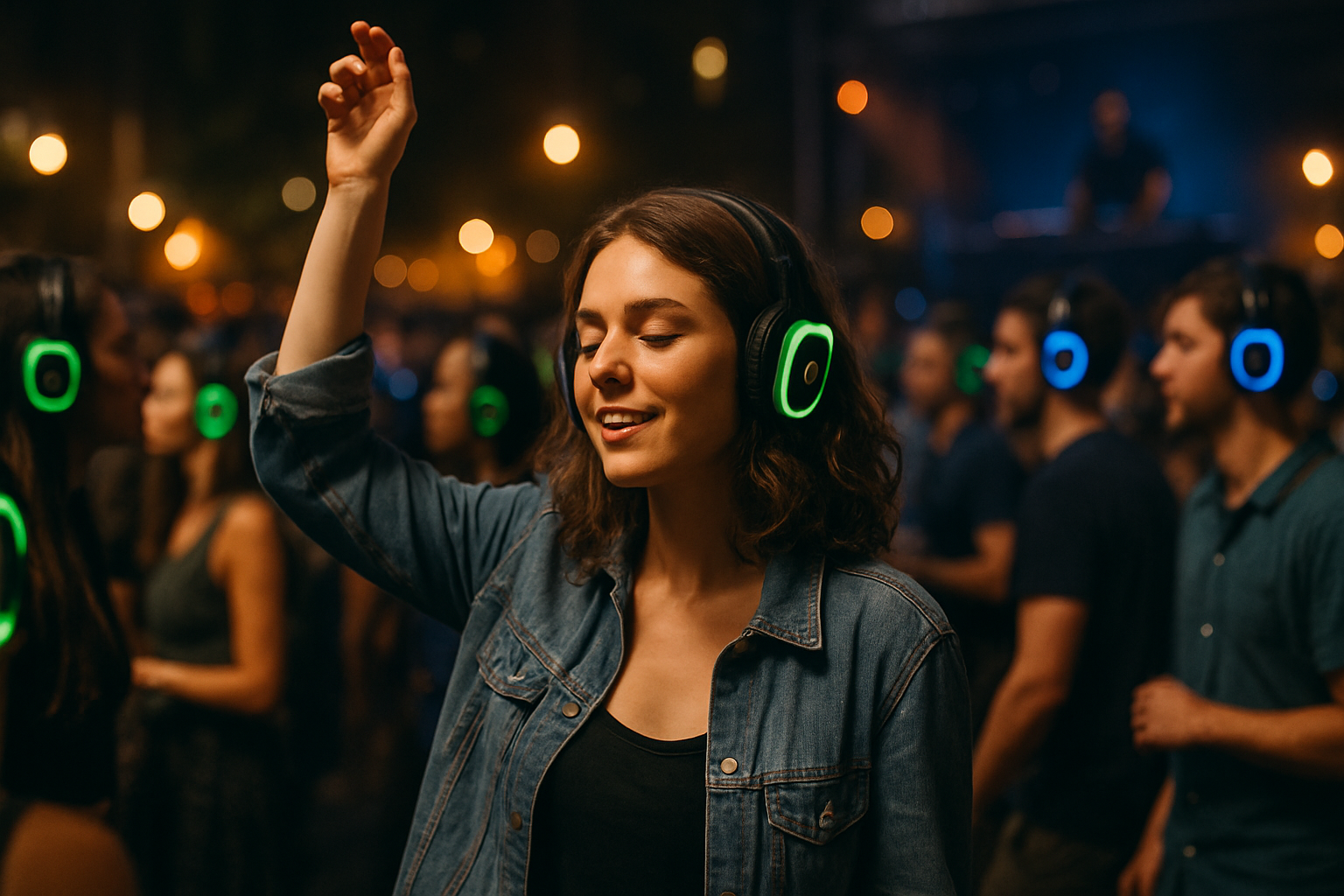Sonic Sanctuaries: The Rise of Silent Discos in Urban Landscapes
The pulsating beats of music fill the air, yet the streets remain eerily quiet. Crowds of people dance in perfect synchronization, their headphones glowing in various colors. Welcome to the world of silent discos, a growing phenomenon reshaping nightlife and social gatherings in cities across the globe. This innovative approach to communal entertainment is not just a passing trend, but a reflection of changing urban dynamics and evolving social needs. Read below to explore how silent discos are transforming our concept of shared experiences and public spaces.

The idea quickly gained traction, evolving from small, underground gatherings to mainstream events. By the mid-2000s, silent discos had become a staple at music festivals, offering a unique way to extend the festivities without violating noise curfews. The phenomenon soon spread to clubs, public spaces, and even corporate events, captivating a diverse audience with its novel approach to communal enjoyment.
A Symphony of Social Connection
At first glance, the idea of a silent disco might seem paradoxical – how can a shared musical experience be silent? However, this apparent contradiction is precisely what makes silent discos so intriguing from a sociological perspective. These events create a unique form of social interaction, blending individual experiences with collective engagement in ways that traditional nightlife cannot match.
Participants in silent discos often report a heightened sense of connection with fellow dancers, despite the lack of audible music. The shared experience of moving to the same rhythm, visible through synchronized movements but inaudible to outsiders, creates a strong sense of community and belonging. This paradoxical combination of isolation and unity offers a fascinating microcosm of modern urban life, where individuals seek connection amidst the anonymity of city living.
Urban Adaptation and Spatial Reclamation
One of the most significant impacts of silent discos has been their ability to transform and reclaim urban spaces. Traditional nightlife venues are often restricted by zoning laws, noise ordinances, and neighborhood complaints. Silent discos, however, can be held in a wide variety of locations without causing disturbance, from public parks and rooftops to historical landmarks and museums.
This flexibility has led to a reimagining of urban nightlife and the use of public spaces. Cities around the world are embracing silent discos as a way to activate underutilized areas, promote tourism, and offer residents new ways to engage with their environment. For example, silent disco tours have become popular in many cities, allowing participants to explore urban landscapes while dancing to curated playlists, effectively turning entire neighborhoods into impromptu dance floors.
The Technology Behind the Silence
The rise of silent discos is intrinsically linked to advancements in wireless technology. Modern silent disco setups typically use radio frequency (RF) or infrared (IR) systems to transmit audio to wireless headphones. These systems allow for multiple channels, enabling participants to choose between different DJs or genres, adding an extra layer of personalization to the experience.
Recent innovations have pushed the boundaries even further. Some companies now offer smartphone-based systems, where participants use their own devices and headphones, connected through a dedicated app. This approach not only reduces equipment costs but also allows for more interactive features, such as real-time voting on songs or visualizations synchronized with the music.
Silent Discos and Mental Well-being
Beyond their entertainment value, silent discos are beginning to gain attention for their potential mental health benefits. The unique environment created by these events – a balance of social interaction and personal space – can be particularly appealing to individuals who find traditional nightlife settings overwhelming or anxiety-inducing.
Research in the field of music therapy has long established the positive effects of music on mental health, including stress reduction and mood improvement. Silent discos offer a way to harness these benefits in a social setting, potentially providing a more inclusive nightlife option for those who might otherwise feel excluded.
Cultural Impact and Future Trends
As silent discos continue to gain popularity, they are influencing broader cultural trends and challenging traditional notions of entertainment and social gathering. The concept has inspired variations like silent cinema, where viewers watch films with wireless headphones in public spaces, and silent conferences, where attendees can switch between multiple speakers or language translations without disturbing others.
Looking ahead, the future of silent discos seems bright and full of potential. As urban populations continue to grow and cities grapple with noise pollution and space constraints, these events offer a creative solution that balances individual freedom with communal harmony. Furthermore, as technology continues to advance, we can expect to see even more innovative applications of the silent disco concept, potentially revolutionizing not just nightlife, but how we interact with our urban environments and each other.
In conclusion, silent discos represent more than just a novel way to party – they embody a shift in how we think about shared experiences, public spaces, and the balance between individual expression and community engagement. As our cities evolve and our need for connection persists, these sonic sanctuaries may well become an integral part of the urban social fabric, offering a harmonious blend of technology, entertainment, and human connection in the heart of our bustling metropolises.





